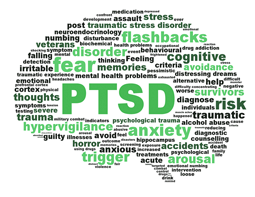Post-traumatic stress disorder
| Tell me about your mother Psychology |
| For our next session... |
| Popping into your mind |
Post-Traumatic Stress Disorder is a psychological condition that surfaces after — sometimes, long after — particularly high-stress life experiences, usually involving death and suffering. The most well-known instances of PTSD are war veterans who experienced combat; and victims of rape.[1] Though less known, children in foster care are more likely than combat veterans to develop PTSD.[2]
PTSD sometimes becomes apparent after lying dormant in the subconscious until something triggers recollection of the memory, or other minor stresses build up upon the previous high-stress experience.
Symptoms and effects[edit]
The core symptoms of PTSD are re-experiencing, avoidance or numbing, and hyper-arousal.[3] This can look like:
- Insomnia, nightmares, night terrors
- Intrusive thoughts; flashbacks
- Difficulty imagining and planning for the future
- Avoiding places, dates, times, people and other reminders of the trauma
- Emotional numbness
- Detachment
- Mood swings
- Anger
- Hypervigilance
- Guilt and self-blame
- Loss of appetite[note 1]
- Inability to cope with mundane tasks
- Loss of drive, both sexual and mental
- Feeling undeserving of help (often with the rationale "other people have had it worse")
In some cases, PTSD can cause physical symptoms such as aches and pains or even seizures.[4]
Complex PTSD[edit]
Complex PTSD is a subtype of PTSD that is caused by repeated traumatic incidents that the person could not escape from. These include child abuse, domestic violence, repeated bullying victimization, human trafficking, living in crisis conditions or a war zone, and more.[3][5] Complex PTSD works its way into the personality, leaving the person feeling powerless and unable to connect meaningfully with other people.
In addition to the usual symptoms of PTSD, someone with complex PTSD will experience:[3][6][7]
- Emotional dysregulation: The person has extreme emotions or flattened emotions, and may switch between the two
- Altered consciousness: Attention difficulties, dissociation, memory gaps, or even forgetting traumatic incidents
- Altered beliefs: Negative self-concept, belief that the world is a cruel or dangerous place, loss of faith in humanity
- Harmed relationships: Difficulty trusting others, trouble with interactions, abuse re-victimization, isolation (sometimes extreme)
- Altered perception of the perpetrator(s): Hating the perpetrator, wanting to appease the perpetrator, agreeing with the perpetrator, wanting revenge (and sometimes cycling in between)
Treatment for complex PTSD falls into 3 phases: (1) reducing symptoms, improving coping skills, and helping the victim feel safe, (2) working through unresolved aspects of the trauma, and (3) reducing isolation and helping the person integrate into the community.[3] Complete recovery may be possible, and even for people who do not fully recover, therapy can greatly improve quality of life.[7]
Controversies[edit]
Some... people, including notable liberal George Carlin, posit that PTSD is a "politically correct" euphemism for what was previously called shell shock.[note 2] In reality, the term "post-traumatic stress disorder" came around for the sole purpose of efficiency — streamlining the DSM. Calling shell shock PTSD is about as politically correct as calling your poodle a dog.
Denialism[edit]
There are some people who are actually in denial over the scientific evidence for PTSD; some of these folks include veterans, those in the medical community (!), and some in the U.S. military who view it as simply a mental weakness.[8][9]
Much of the denial is thought to be in reaction to the stigma attached to mood or anxiety disorders.[8] Trauma survivors may be thought of as "weak" or "too emotional" despite what they have lived through.
Possible over-diagnosis[edit]
PTSD is likely over-diagnosed.[8] Doctors may overuse it without looking at other reasons for someone's behavior, such as borderline personality disorder, autism, or a different condition that could look similar to PTSD.
Some people are self-diagnosing PTSD. It is already tremendously difficult for people with PTSD to receive help, considering it is part of their condition to want to avoid talking about the trauma and blame themselves for what occurred. However, consulting a professional is important, both to ensure an accurate diagnosis and to get appropriate treatment and support.
Trigger warnings[edit]
Trigger warnings can be used in an attempt to make life easier for people with PTSD.
Research has shown that trigger warnings have little effect on people who see the material.[10] However, the warnings can allow people to opt out of reading or watching something that would cause a symptom flare-up, let them wait until they feel more emotionally stable, or at least be mentally prepared to face the content, so the warnings can still be useful. However, prolonged avoidance may do more harm than good and can even amplify PTSD instead.
Notes[edit]
- ↑ Thankfully, no enterprising soul has yet suggested using PTSD as a weight loss tool.
- ↑ And before that, cowardice.
References[edit]
- ↑ Olszewski TM, Varrasse JF (2005). "The neurobiology of PTSD: implications for nurses". Journal of Psychosocial Nursing and Mental Health Services 43 (6): 40–7.
- ↑ Dubner AE, Motta RW; Motta, RW (June 1999). "Sexually and physically abused foster care children and posttraumatic stress disorder". Journal of Consulting and Clinical Psychology 67 (3): 367–73.
- ↑ 3.0 3.1 3.2 3.3 The ISTSS Expert Consensus Treatment Guidelines For Complex PTSD In Adults (PDF)
- ↑ Dissociative Seizures - Epilepsy Society
- ↑ What is C-PTSD? - Beauty After Bruises
- ↑ How a Diagnosis of Complex PTSD Differs From PTSD - Very Well Mind
- ↑ 7.0 7.1 What to know about complex PTSD - Medical News Daily
- ↑ 8.0 8.1 8.2 NBC News: PTSD may be overdiagnosed, but PTSD deniers are 'wrong,' psychologists say 26 November 2012
- ↑ The Urgent Need for Confidential Psychological Care for U.S. Military
- ↑ The Real Problem With Trigger Warnings
